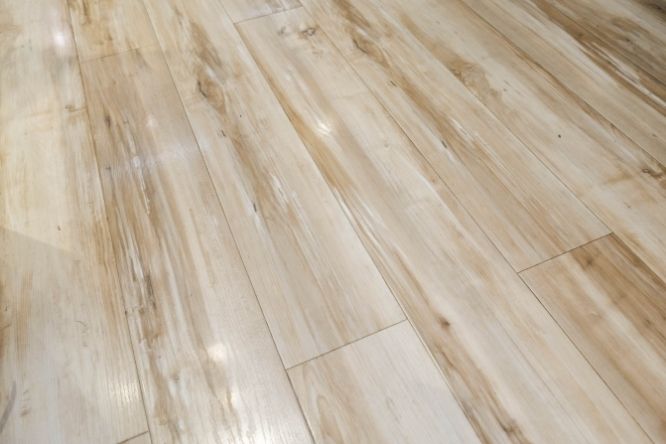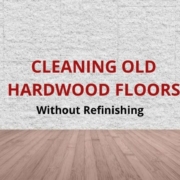How to Remove Wax Buildup From Wood Floors
In terms of interior decor, hardwood floors have long been considered ideal for bestowing an ambiance of sophistication, or rustic appeal on homes, schools, or workspaces.
However, they also have very specific maintenance requirements such as waxing. This procedure is ideal for finished and unfinished hardwood floors and can restore their natural sheen. Waxing hardwood surfaces can also enhance their longevity and also protect them from getting stained frequently.
However, over time, the wax used tends to build up. When this happens, your floor will no longer display a smooth polished appearance making it necessary for the excess wax to be removed.
This article takes a close look at this issue and how to resolve it. We discuss how to remove wax buildup from hardwood floors, the best products for doing so, and what products you must avoid.
Why Should You Remove Wax Buildup on Wood Floors?
1. The Accumulation of Trapped Dirt and Blurriness
As wax accumulates, the use of indoor heaters can melt it and cause debris such as hair, pet fur, or dirt to sink into it. It can also result in scuff marks being made in it as well.
Wax buildup will make your floors look blurred and cloudy in addition to trapping particles.
2. The Presence of Scratches
Over time, your hardwood floor will get scratched, either by your pets or simply by grit that clings to the soles of feet, stockings, and footwear. To refinish it, you will need to get rid of the overlying layer of accumulated wax covering it.
3. Slight Water Damage
Occasionally, water damage may cause a whitish discoloration on certain parts of your floor. This is caused by the moisture penetrating the wax and part of the process of remedying the damage will involve removing any wax on the floor.
Checking for Wax Buildup
If you have noticed any stains, scratches, or even general dullness on your floor or simply wish to refinish it, you will need to find out if there is a layer of wax you need to get rid of first.
You can do so by using the following:
- Sandpaper: Lightly pass sandpaper across the floor. If there is any wax present, it will ball up.
- Mineral Spirits: Apply a small amount (no more than a few drops) of mineral spirits to a cloth. Next, wipe the floor with it. The presence of a brownish, yellowish, or even whitish smear means that there is wax on your floor.
- Water: Simply place a drop of water on your floor and wait for a minute. The appearance of a white spot beneath the drop within that timeframe will indicate the presence of wax.
The Best Wood Floor Wax Removers
Mineral Spirits
Also referred to as turpentine substitute, and white spirit, this petroleum-derived solvent is cheap, mild smelling, and low in VOCs (volatile organic compounds). It is also capable of dissolving the wax on your floor enabling you to remove it from the surface completely.
Although mineral spirits may affect certain surfaces adversely, it does not do so to wood and is therefore suitable for hardwood floors as a result. However, the solvent is unsuitable for no-wax surfaces since it will strip them of their gleaming finish, leaving them with a matte, dull appearance.
It is also flammable and should be handled with caution.
Sunnyside Corporation’s Mineral Spirits is an excellent example of mineral spirits which can be used for this purpose. This particular product has been produced by the Sunnyside brand which has been manufacturing potent solvents for over a century.
In addition to being low odor and suitable for use on wooden floors, it is also ideal for cleaning paint brushes, rollers and sprayers, and degreasing mechanical components.
Products Which Are Unsuitable for Removing Wax Buildup
- Acetone: A colorless, flammable, and volatile fluid, acetone is also known to be a highly effective solvent. It is capable of dissolving grease and is also capable of stripping wax from hardwood floors. However, acetone is unsuitable for this purpose because it may not only damage the finish of your floors but will also discolor the wood as well.
- Commercial Wax Removers: Special care must be taken when selecting products in this category since the wrong choice can turn out to be particularly harsh on your hardwood surfaces. As a result, you will need to ensure that the product you select has specifically been manufactured for hardwood floors and is approved by your manufacturer.
- Homemade Ammonia/Vinegar Solutions: Hot water solutions of ammonia and vinegar are highly popular homemade remedies for stripping floor wax. And while they may be efficient, it is worth noting that the extensive exposure of your floor to hot water will place it at risk of water damage.
How to Remove Wax Buildup on Hardwood Floors
Things You’ll Need
- A soft-bristled brush
- Absorbent cloths
- Mineral spirits
- Steel wool
- Rubber gloves
- A face mask
- Knee pads
1. Prepare the Room
Empty the room of all furniture and open every window and door. Using a soft-bristled brush or broom, sweep the floor clean of dust and debris.
2. Remove the Surplus Wax
This process is especially time-consuming and effort-intensive. You will need to apply the mineral spirits to the floor using a spray bottle and scrub it with the steel wool.
If your floor comes with bevels, you will also need to scrape them manually to get rid of the wax in the crevices.
As the wax is loosened you will need to wipe it off the surface and taking another cloth, wipe the floor clean.
3. Clean Any Left Over Residue
Once you have finished cleaning each section, you will need to clean the floor with an additional application of mineral spirits to new clean cloths. This last step will ensure that no wax residue has been left behind.
Certain experts recommend carrying out this step twice. To ensure you have been thorough in removing all the wax, simply apply mineral spirits to another clean cloth and go over the section you have cleaned.
The absence of any residue on the cloth will mean that every trace of wax has been removed. However, the presence of any coloration as noted above will mean that you will need to go over that part of the surface with a cloth and mineral spirits, once more.
What You Can Do Following Wax Buildup Removal
Now, you know how to remove wax from hardwood floors. But what else will you be able to do following the procedure?
1. Apply a Fresh Coat of Wax
To protect your hardwood flooring from stains and conceal slight blemishes, you will have the option of applying a fresh coat of paste or liquid wax. You can take a look at our article on how to wax hardwood floors – it covers the procedure in detail and looks at the best products for your hardwood floors.

2. Repair Slight Water Damage
If you intend to get rid of white spots on your floor caused by water as referenced above, you will need to sand the affected area once you have removed the wax, and then wipe it repeatedly with an oxalic acid crystal solution until the stain is eliminated. Once you have done so you will be able to stain or seal it before refinishing it.
3. Eliminate Scratches and Scarring.
If your hardwood floor happens to be excessively damaged by scratches or scarring, you will be able to sand it. And once you are through you will be able to apply a brand new finish of your choice, restoring your floor’s original classic appeal.
* Last updated on 2024-07-27 / We are using affiliate links / All images are served from the Amazon Product Advertising API.
Table of Contents







